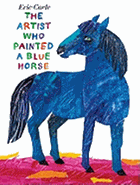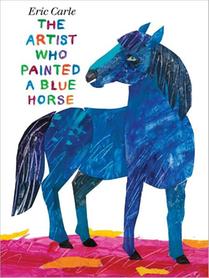
 As with most of Eric Carle's work, this beautifully conceived picture book is deceptively simple. "I am an artist and I paint...," the book begins. A boy in a striped T-shirt and jeans applies blue paint to a virgin gold background. His palette of many colors appears on a gray table beside him. A turn of the page reveals the completed composition: "a blue horse" with a black mane, begun with that first blue stroke. He follows with a painting of a red crocodile against a white background with a band of teal blue at the top to indicate its aquatic habitat. Next comes a saturated portrait of a yellow cow. Carle fills the background with deep dark blues and greens, and dots the sky with stars. The golden hues of the cow pulse against the night sky. Thus Carle introduces the three primary colors: blue, red and yellow.
As with most of Eric Carle's work, this beautifully conceived picture book is deceptively simple. "I am an artist and I paint...," the book begins. A boy in a striped T-shirt and jeans applies blue paint to a virgin gold background. His palette of many colors appears on a gray table beside him. A turn of the page reveals the completed composition: "a blue horse" with a black mane, begun with that first blue stroke. He follows with a painting of a red crocodile against a white background with a band of teal blue at the top to indicate its aquatic habitat. Next comes a saturated portrait of a yellow cow. Carle fills the background with deep dark blues and greens, and dots the sky with stars. The golden hues of the cow pulse against the night sky. Thus Carle introduces the three primary colors: blue, red and yellow.
But this is not an art lesson in the standard sense; he doesn't follow next with binary and tertiary colors (though they do appear here). Carle's book urges children to break the rules when it comes to creativity. He stays true to the animals' musculature and defining features, then populates the pages with a pink rabbit, a black polar bear and a polka-dotted donkey. He alternates the direction in which they face, the postures of the animals and the band of color that suggests the ground or sky to hold a child's visual interest. The palette Carle shows us at the beginning contains all of the colors he uses in the book; at the end we see how thoroughly the young artist employed his palette, with colors blended and paint splattered on shirt, pants and table.
Carle often strays from convention. The blue elephant on the cover of Do You Want to Be My Friend? grabs readers' attention and shifts the focus to the gray mouse in search of a companion. His "very hungry caterpillar" may not look like most found in nature, but it served Carle's purpose to teach the days of the week, counting to 10 and the eventual metamorphosis of the tiny hero into a "beautiful butterfly." This book, which he calls an "homage to Franz Marc," who painted Blue Horse I at the turn of the 20th century, teaches children to trust their own unique perceptions, and to render the world as they see it. Most literally, Carle's encouragement applies to artists, but also to budding writers, dancers and musicians, as well as aspiring Einsteins and architects. Know the rules, Carle seems to say, and then make them yours. --Jennifer M. Brown

